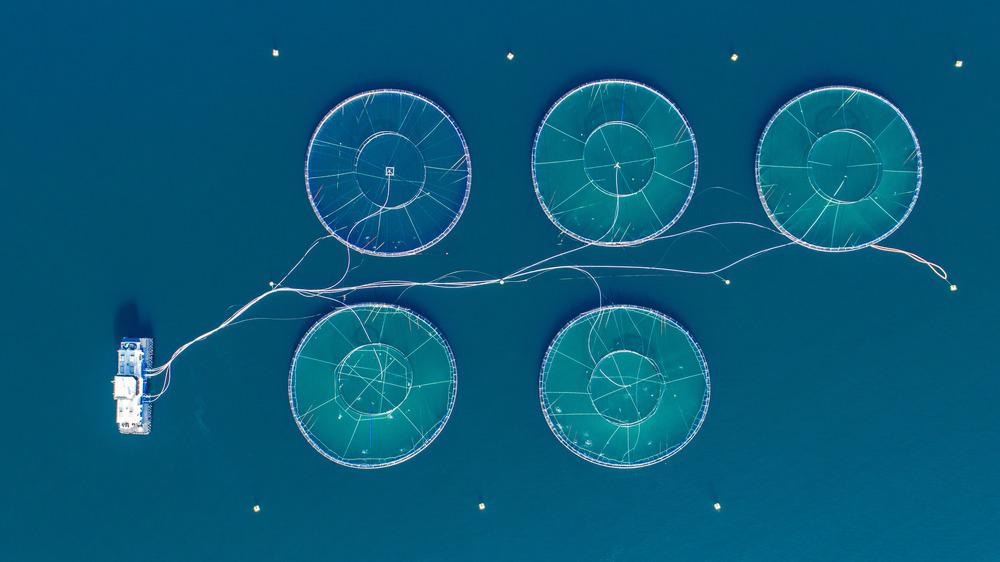A paper published in the journal ACS Applied Bio Materials demonstrates the feasibility of nanocomposites synthesized from silver nanoparticles (AgNPs) and carbon nanodots (C-dots) as an antibacterial agent against bacterial infections in fish, specifically in freshwater-farmed fish.

Study: Green Synthesis of Silver–Carbon Nanocomposites with Extraordinary Stability and Robust Antibacterial Activity against Bacterial Diseases in Fish. Image Credit: Marius Dobilas/Shutterstock.com
Background
The rapid expansion and development of the aquaculture industry in recent years has gradually increased the incidence of severe diseases caused by bacterial infections in fish.
Pathogenic bacterial infections are leading to a substantial economic impact on the aquaculture industry owing to their extensive and rapid transmissibility, which increases the difficulty in treatment, as well as morbidity and mortality in fish. Thus, the treatment and prevention of bacterial diseases remain among the top priorities for the aquaculture industry.
The application of commonly used sterilization methods, such as thermal sterilization, against bacterial infections in fish, is extremely difficult owing to the limitations associated with the aquaculture conditions.
Similarly, the use of antibacterial reagents, such as potassium permanganate and antibiotics, can potentially lead to bacterial resistance and harmful effects on human health.
Nanomaterials, such as zinc oxide nanoparticles and AgNPs, demonstrated significant potential as an antibacterial agent. Among them, AgNPs displayed more effectiveness compared to other nanomaterials owing to their low cytotoxicity to human cells and high antimicrobial efficiency.
However, the practical applications of AgNPs are limited as AgNPs easily oxidize and aggregate, which can reduce their effectiveness against Gram-negative bacteria. Thus, in this study, researchers synthesized carbon nanodot and AgNP composite (AgNPs@C-dots) and investigated its effectiveness as a therapeutic and preventive agent against fish bacterial diseases.
The antibacterial properties of the synthesized AgNPs@C-dots were evaluated against Aeromonas salmonicida, a common fish pathogen responsible for several diseases in carps. Additionally, AgNPs@C-dots were applied to zebrafish in order to investigate the changes in disease resistance of zebrafish after bacterial infection due to AgNPs@C-dots.
The Study
Sodium hydroxide (NaOH), silver nitrate (AgNO3), and C-dot aqueous solution were used as starting materials in the preparation of AgNPs@C-dots. 0.07 mg of AgNO3 and 0.4 mg of NaOH were mixed with 1 mL of 0.07 mg mL-1 C-dot aqueous solution, and the mixture was incubated for 18 min at room temperature.
The chemically reduced AgNPs were prepared by initially boiling 100 mL of 100 mM AgNO3 aqueous solution, and then rapidly adding 1 mL of 10% sodium citrate solution to the boiled solution under vigorous stirring. Subsequently, the mixed solution was again boiled for 10 min and then stirred for 15 min. AgNPs were obtained after the mixture was cooled down.
The stability of the antibacterial application of AgNPs@C-dots was determined by incubating them with a lysogeny broth (LB) medium containing river water or lake water and 108 CFU mL-1 Aeromonas salmonicida, while the salt stability of the composite was evaluated by immersing it in different concentrations of sodium chloride (NaCl) solutions.
Additionally, AgNPs@C-dots were placed at room temperature for 30 days to assess their long-term stability. The bacterial sensitivity to nanomaterials was evaluated using the disk diffusion test.
The antibacterial characteristics of AgNPs@C-dots were assessed by adding 106 CFU mL-1 Aeromonas salmonicida to a 3 mL liquid LB broth medium supplemented with various concentrations of AgNPs@C-dots.
The AgNPs@C-dots-treated bacteria were stained with calcein acetoxymethyl ester (calcein-AM) and propidium iodide (PI) in the dark for 1 h in order to visualize dead and live cells using confocal laser scanning microscopy (CLSM).
Morphological changes in the AgNPs@Cdots-treated bacteria were observed using scanning electron microscopy (SEM), while the reactive oxygen species (ROS) level of Aeromonas salmonicida cells was detected by performing e 2′,7′ dichlorodihydrofluorescein diacetate (DCFH-DA) assay. The bacterial protein and DNA leakage were detected using agarose gel electrophoresis and sodium salt (SDS)-polyacrylamide gel electrophoresis (SDS-PAGE).
A cell counting kit 8 (CCK-8) assay was employed to measure in vitro cytotoxicity, while the overall Ag concentrations in zebrafish tissue samples were evaluated according to the Chinese National Standard GB/T 38261-2019.
Observations
Monodispersed AgNPs@C-dots were synthesized successfully with high biocompatibility and stability.
The synthesized AgNPs@C-dots displayed significantly higher stability under different harsh conditions, such as during long-term storage and in high ionic strength solutions, compared to the chemically reduced AgNPs owing to the modifications caused by C-dots.
The antibacterial assay results systematically demonstrated an exceptional antibacterial activity of AgNPs@C-dots against Aeromonas salmonicida. In vitro antibacterial results demonstrated that AgNPs@C-dots can effectively annihilate Aeromonas salmonicida at 9.5 μg mL-1 concentration.
AgNPs@C-dots damaged the bacterial cell membrane integrity, leading to leakage of cytoplasm, production of ROS, and eventual annihilation of the bacteria. Additionally, AgNPs@C-dots displayed greater biocompatibility with trace residues in fish and human cells.
The resistance of zebrafish against Aeromonas salmonicida was improved following the application of AgNPs@C-dots. Additionally, no detectable amount of Ag was observed in the muscles of zebrafish after the exposure of zebrafish to AgNPs@C-dots for 30 days.
Taken together, the findings of this study demonstrated that AgNPs@C-dots can be used to develop effective antibacterial agents in aquaculture in order to control bacterial diseases.
Reference
Lu, Q., Zhang, C., Liu, M. et al. (2022) Green Synthesis of Silver − Carbon Nanocomposites with Extraordinary Stability and Robust Antibacterial Activity against Bacterial Diseases in Fish. ACS Applied Bio Materials https://pubs.acs.org/doi/10.1021/acsabm.1c01116.
Disclaimer: The views expressed here are those of the author expressed in their private capacity and do not necessarily represent the views of AZoM.com Limited T/A AZoNetwork the owner and operator of this website. This disclaimer forms part of the Terms and conditions of use of this website.